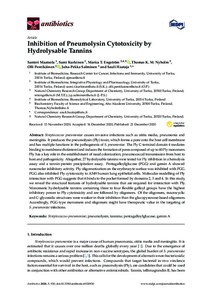Inhibition of Pneumolysin Cytotoxicity by Hydrolysable Tannins
Santeri Maatsola; Sami Kurkinen; Marica T. Engström; Thomas K. M. Nyholm; Olli Pentikäinen; Juha-Pekka Salminen; Sauli Haataja
Inhibition of Pneumolysin Cytotoxicity by Hydrolysable Tannins
Santeri Maatsola
Sami Kurkinen
Marica T. Engström
Thomas K. M. Nyholm
Olli Pentikäinen
Juha-Pekka Salminen
Sauli Haataja
MDPI
Julkaisun pysyvä osoite on:
https://urn.fi/URN:NBN:fi-fe2021042824916
https://urn.fi/URN:NBN:fi-fe2021042824916
Tiivistelmä
Streptococcus pneumoniae causes invasive infections such as otitis media, pneumonia and meningitis. It produces the pneumolysin (Ply) toxin, which forms a pore onto the host cell membrane and has multiple functions in the pathogenesis of S. pneumoniae. The Ply C-terminal domain 4 mediates binding to membrane cholesterol and induces the formation of pores composed of up to 40 Ply monomers. Ply has a key role in the establishment of nasal colonization, pneumococcal transmission from host to host and pathogenicity. Altogether, 27 hydrolysable tannins were tested for Ply inhibition in a hemolysis assay and a tannin-protein precipitation assay. Pentagalloylglucose (PGG) and gemin A showed nanomolar inhibitory activity. Ply oligomerization on the erythrocyte surface was inhibited with PGG. PGG also inhibited Ply cytotoxicity to A549 human lung epithelial cells. Molecular modelling of Ply interaction with PGG suggests that it binds to the pocket formed by domains 2, 3 and 4. In this study, we reveal the structural features of hydrolysable tannins that are required for interaction with Ply. Monomeric hydrolysable tannins containing three to four flexible galloyl groups have the highest inhibitory power to Ply cytotoxicity and are followed by oligomers. Of the oligomers, macrocyclic and C-glycosidic structures were weaker in their inhibition than the glucopyranose-based oligomers. Accordingly, PGG-type monomers and oligomers might have therapeutic value in the targeting of S. pneumoniae infections.
Kokoelmat
- Rinnakkaistallenteet [27094]
